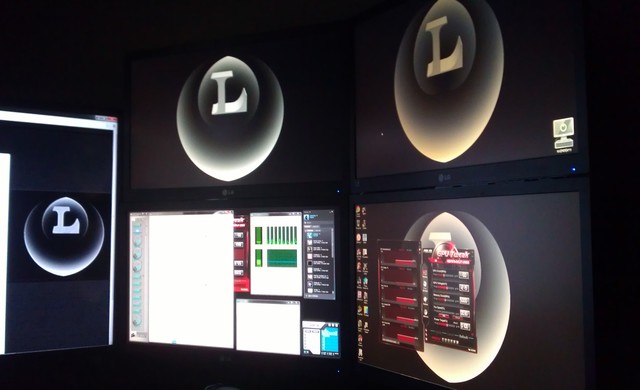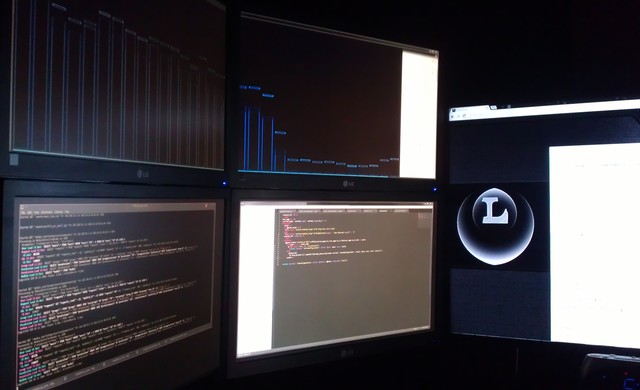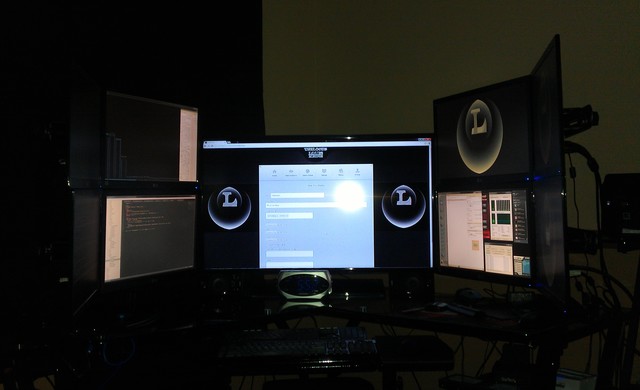The Three Plus Monitors Club
On October 22, 2013 by Louis Alridge
Categorized Under: Technology Monitors
Technology. Sometimes we are reminded by it that to understand the importance of something, we must experience it… Right around the end of my college days, I read these articles about 3 monitor setups by Jeff Atwood. Being a budding programmer at the time and having being stuck with older craigslist desktops and monitors from my college days, I decided it was time for a change. After working at Trinovus for a short amount of time, I hoarded some cash and got to work building the “What if?” rig. I had always been mildly interested in multiple monitors, but it wasn’t until relatively recently that they became affordable past the two stage. You can pick up high quality screens nowadays for less than 400$, and the graphics cards to run at least 3 monitors for that much or less. That said, I knew of the virtues of multiple monitors for productivity, but I still had to ask “Why not more?”
The system displayed in those pictures was the build I put together late 2012. It consists of 8 23” LEDs and 1 42” ultrasharp HDTV as the centerpiece. There were two shifts I had to make when I started using this setup. The first was going from a 23” monitor as my centerpiece to a 42” TV, and the second was getting used to the idea that I had so much _space_. There are two main advantages to moving to an HDTV as your center monitor, first, you can see more pixels which is for a techie, mentally stimulating. Just being able to sit back and comfortably read / view anything on the web without squinting is very nice. I had originally heard that HDTVs were only good for seniors who had trouble making out small fonts, but after using it myself I say its far more useful than that. The caveat, however, is most HDTVs are not designed with acting like a monitor in mind. Most of the cheap ones lack the sharpness to make monitor use rewarding. They have to be native to 1920x1080 resolution at the very least. The second caveat is that you need a good understanding of the different types of HDTVs and the patience to find the monitor that is just right for you. Most HDTVs only handle the latest spec of HDMI so you will not be getting amazing refresh rates, at best with an ultra HDMI cable (HDMI 1.4) you’ll have a good large monitor.
Now for the 23” monitors… a 9 monitor setup lets you do some interesting things. You can have a 3 + 3(2 + TV) + 3 setup where each set of 3 monitors are controlled by a single computer that networks to the others via KVM switch for ease of use. This may be more ideal for work situations but it could be better. Radeon makes graphics cards that can handle up to 6 monitors through a single card. As a side note, you do not want to have two cheap video cards that render data to 2 sets of 3 monitors, this can cause issues whenever you move between the two sets on the same computer. My final configuration ended up being 4 + 1(HDTV) + 1 + 3, with the 3 monitors on the right connected to a legacy windows box and a debian box.
So what do I do with all this space? I draw many parallels with how one uses 9 side by side monitors with how one would use 3 monitors. The main difference is the amount of information that can readily be seen in a 9 monitor setup versus a 3 monitor setup. The catch is that you have to have information you want to see, if you only care about 3 applications, you don’t need 6 screens worth of space unless the app handles scaling very well. As I was an old windows user, the concept of multiple “desktops” never quite appealed to me. I’d rather see everything within a single desktop rather than constantly shifting between multiple desktops to see what I wanted to see. Indeed, switching between multiple desktops is great for productivity when you only have 1-2 screens, but after 3 it starts becoming a hindrance as you can already see everything you want to see.
So is it worth it? Generally no. Is it gratifying as hell for home use? Yes. Does it make you even more curious about where the tech market will go? Yes. And that is my problem, now that I have experienced the raw awesome of 7680x3840 resolution, its really hard to go back. A “4K TV”:https://en.wikipedia.org/wiki/4K_resolution as the centerpiece would be the icing on the cake, but they are still cost and technology prohibitive (HDMI 1.4 cannot push enough data to update the screen faster than 30 fps). The other note being bezels, the edges of screens. Only very expensive screens have bezels less than half a centimeter, most others will have at least a centimeter bezel, which must be corrected for in the graphics program the multi-monitor system utilizes. Not compensating for bezels can be done, but for me it was somewhat disorienting to have the image ignore the bezel instead of being hidden by it. Still, buying 4 monitors for ~800$, a quad monitor stand for ~300 is still cheaper than the cheapest 4K TVs. It is worth noting that most graphics cards produced before last year cannot handle 4K resolution, so you’d still be buying a new graphics card with either a 4K or quad.
Afterword: Gaming on a multi-monitor system is silly outside of very very specific use cases. Most games simply just arent engineered to handle ultra-wide resolutions. At the very best you’ll get 5760x1080 supported in a couple of AAA multiplayer titles. Gaming on an ultrasharp HDTV can also be very disorienting if your eyes can’t process all that visual information (assuming you’re sitting ~3 feet away from the TV). I adjusted to that disorientation, but it was initially very difficult to see everything I needed to see for the user interface for certain games.


